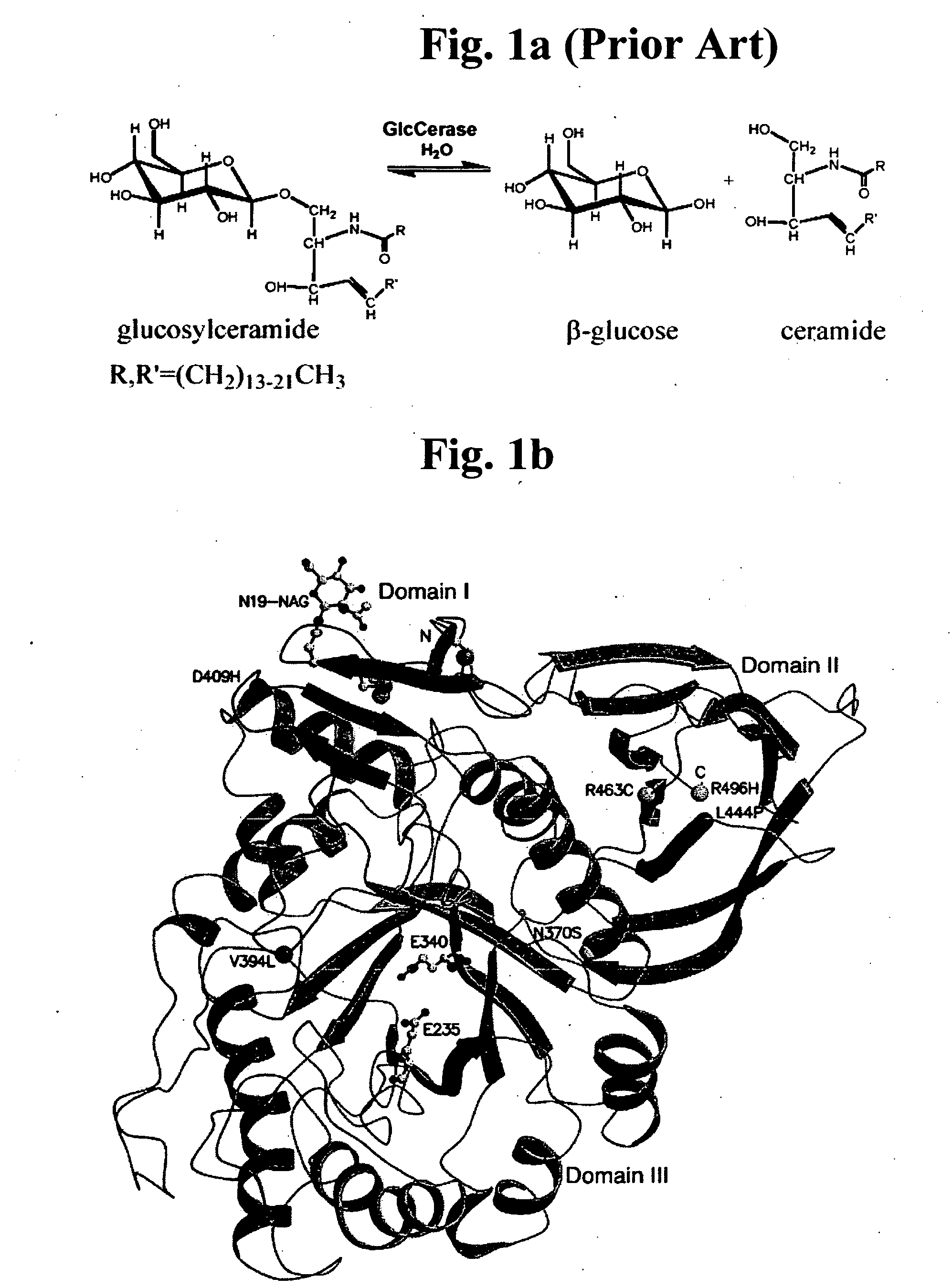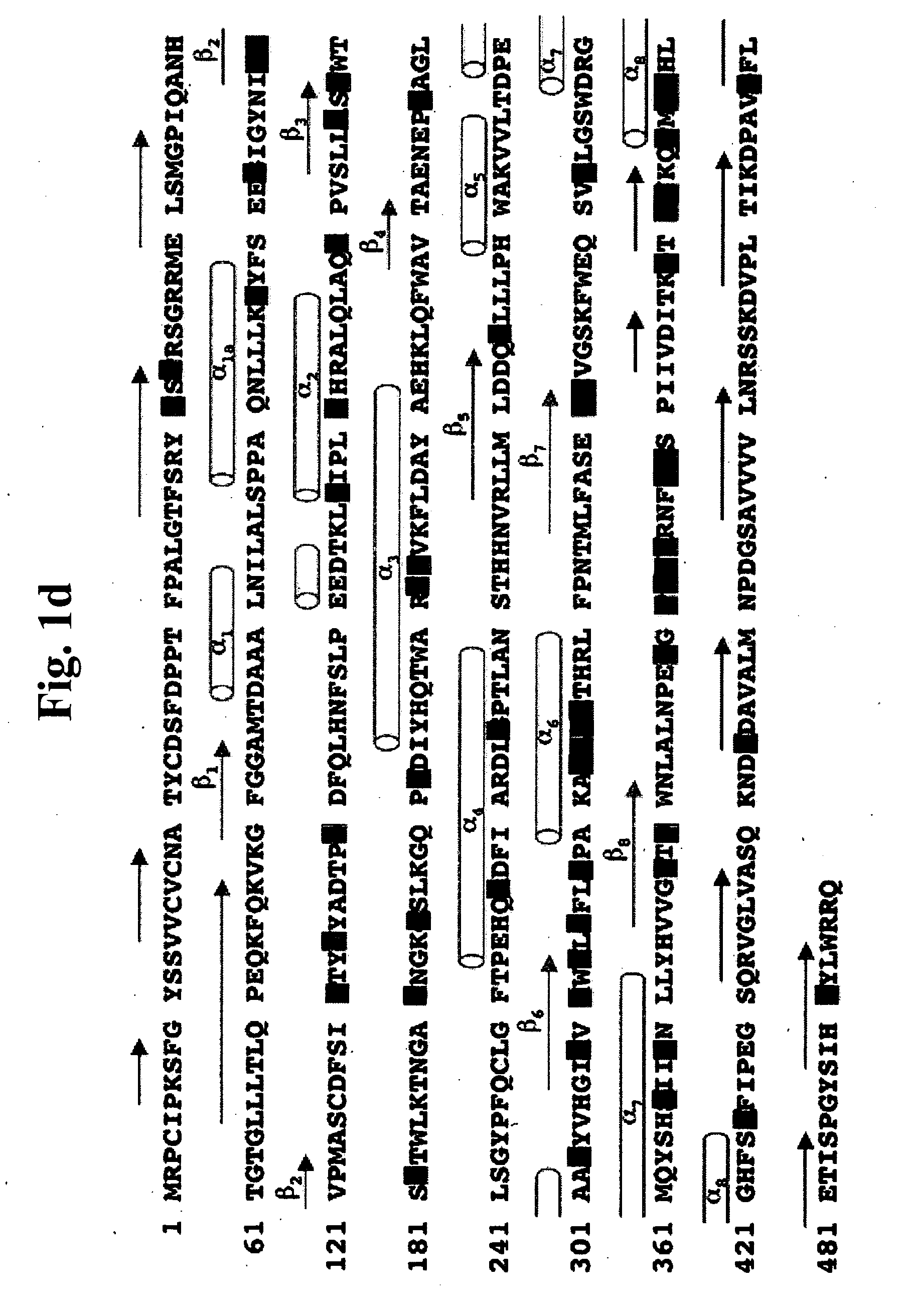Gaucher disease drugs and methods of identifying same
a technology of gaucher disease and drugs, applied in the field of gaucher disease drugs and methods of identifying same, can solve the problems of not curative, anemia and osteopenia, genetic testing dilemma, etc., and achieve the effect of increasing glucocerebrosidase activity and enzymatic stability
- Summary
- Abstract
- Description
- Claims
- Application Information
AI Technical Summary
Benefits of technology
Problems solved by technology
Method used
Image
Examples
example 1
The 3D Atomic Structure of Human Glucocerebrosidase
[0459] Gaucher disease is a highly debilitating disease caused by mutant glucocerebrosidase molecules having impaired enzymatic activity, and for which no satisfactory treatment is available. An optimal drug for treatment of Gaucher disease would be of optimally small dimensions, have a non-polypeptidic composition, and would be capable of correcting impaired glucocerebrosidase enzymatic activity in mutant glucocerebrosidase molecules associated with pathogenesis of the disease. Ideally, such compounds could be computationally identified using computing platforms capable of generating atomic resolution models representing 3D atomic structures of glucocerebrosidase molecules. The prior art, however, has failed to provide computing platforms suitable for performing such rational drug design. As described below, while reducing the present invention to practice, the present inventors have overcome the limitations of the prior art by pr...
example 2
The Essentially Complete, Optimally Accurate, Predicted 3D Atomic Structure of Human Glucocerebrosidase Mutants Associated with Gaucher Disease
[0475] As described above, whole enzyme replacement therapy using recombinant glucocerebrosidase is currently the treatment of choice for treatment of Gaucher disease. Such treatment, however, suffers from numerous significant drawbacks, as described above. Hence, novel and improved Gaucher disease drugs are urgently required. Optimal Gaucher disease drugs, would be compounds having optimally small dimensions and a non-polypeptidic chemical composition, and would be capable of interacting with mutant glucocerebrosidase molecules associated with Gaucher disease in such a way as to correct impaired enzymatic activity thereof. Ideally, such compounds could be computationally identified using computing platforms capable of generating essentially complete, experimentally determined, models representing 3D atomic structures of human glucocerebrosi...
example 3
Partially Glycosylated Human Glucocerebrosidase has Greatly Increased Stability Under Physiological Conditions Relative to Fully Glycosylated Glucocerebrosidase, While Retaining Full Biological Functionality: Optimal Gaucher Disease Drug
[0498] Background: As described above, whole enzyme replacement therapy using fully glycosylated human glucocerebrosidase, such as Cerezyme®, is currently the treatment of choice for treatment of Gaucher disease. Such treatment, however, is suboptimal since it does not satisfactorily alleviate the symptoms of the disease. Treatment of Gaucher disease with such a fully glycosylated glucocerebrosidase has the additional disadvantages of requiring administration with suboptimally high frequency, and of concomitantly being suboptimally expensive. One potential strategy to overcome these limitations would be to identify / design novel glucocerebrosidase molecules having enhanced stability under physiological conditions relative to fully glycosylated glucoc...
PUM
| Property | Measurement | Unit |
|---|---|---|
| concentration | aaaaa | aaaaa |
| temperature | aaaaa | aaaaa |
| temperature | aaaaa | aaaaa |
Abstract
Description
Claims
Application Information
 Login to View More
Login to View More - R&D
- Intellectual Property
- Life Sciences
- Materials
- Tech Scout
- Unparalleled Data Quality
- Higher Quality Content
- 60% Fewer Hallucinations
Browse by: Latest US Patents, China's latest patents, Technical Efficacy Thesaurus, Application Domain, Technology Topic, Popular Technical Reports.
© 2025 PatSnap. All rights reserved.Legal|Privacy policy|Modern Slavery Act Transparency Statement|Sitemap|About US| Contact US: help@patsnap.com



